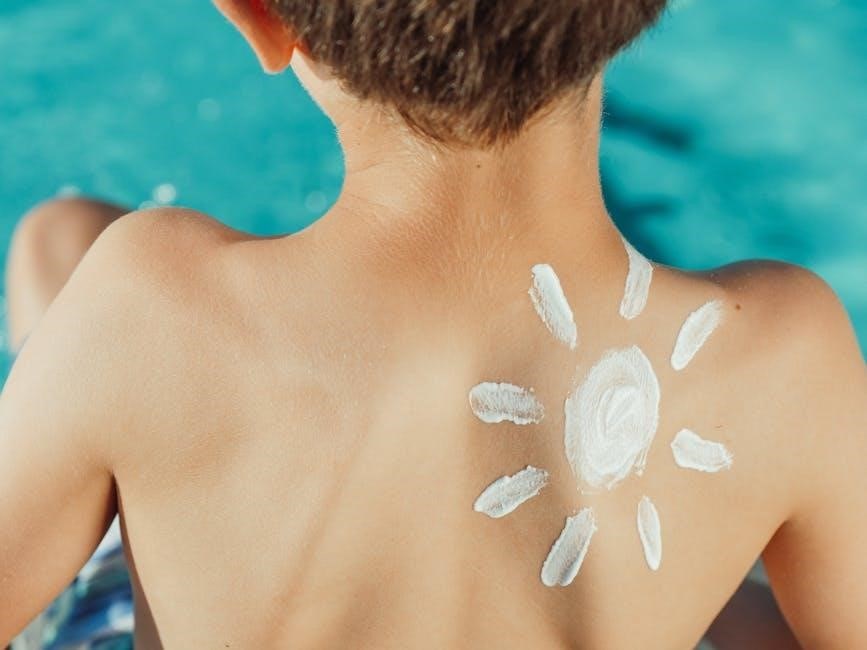Discover the ultimate Pool Care Cheat Sheet, your go-to guide for maintaining a clean, safe, and sparkling pool. Learn essential tips, schedules, and chemical balance secrets to ensure your pool stays pristine year-round.
Why Proper Pool Maintenance Matters
Proper pool maintenance is crucial for ensuring safety, cleanliness, and longevity. Regular care prevents contamination, reduces chemical imbalances, and avoids costly repairs. A well-maintained pool enhances swimming experiences, protects equipment, and maintains property value. Neglecting upkeep can lead to health risks, cloudy water, and damaged systems. Consistent maintenance routines, as outlined in the Pool Care Cheat Sheet, help pool owners enjoy a safe, functional, and visually appealing pool year-round.
Overview of the Pool Care Cheat Sheet
The Pool Care Cheat Sheet is a comprehensive guide designed to simplify pool maintenance. It covers daily, weekly, and monthly tasks, essential chemicals, and troubleshooting tips. The guide includes formulas for calculating pool volume, seasonal checklists, and safety precautions. Whether you’re a new or experienced pool owner, this cheat sheet provides practical advice to keep your pool clean, safe, and well-maintained throughout the year. It’s an indispensable resource for ensuring optimal pool health and longevity;

Pool Anatomy 101
Understand the essential components of your pool system, including skimmers, pumps, filters, jets, and heaters. These elements work together to ensure proper circulation and maintenance for optimal pool function.
Key Components of a Pool System
Every pool system relies on essential components to function efficiently. The skimmer collects surface debris, while the pump circulates water through the filter, which removes impurities. Jets distribute clean water, and heaters regulate temperature. These parts work together to maintain clean, safe, and balanced water conditions, ensuring optimal pool performance and longevity. Understanding each component’s role is vital for effective pool maintenance and troubleshooting.
Understanding Pool Volume and Calculations
Calculating your pool’s volume is crucial for proper chemical dosing and maintenance. For rectangular pools, use the formula: length × width × depth × 7.5. For irregular shapes, break the pool into sections and calculate each area separately. Accurate measurements ensure precise chemical balance, preventing over- or under-treatment. Refer to the Pool Care Cheat Sheet for detailed charts and formulas to simplify these calculations and keep your pool water safe and clear.

Regular Pool Maintenance Tasks
Keep your pool sparkling with daily, weekly, and monthly tasks. Skim debris, vacuum floors, and check filter pressure. Regular maintenance ensures clear water and prevents costly issues.
Daily Pool Care Routine
Start your day by skimming debris from the surface and vacuuming the pool floor. Run the filter for 8-12 hours to maintain clear water. Check the pressure gauge and clean the skimmer baskets. Inspect the pool jets to ensure proper water circulation. Monitor chlorine and pH levels, adjusting as needed. Hose down the deck to remove dirt and ensure a clean environment. These simple steps keep your pool sparkling and healthy every day.
Weekly Pool Maintenance Checklist
Test and adjust chlorine, pH, and CYA levels for optimal water balance. Clean the filter according to the manufacturer’s instructions and rinse skimmer baskets. Inspect pool equipment for signs of damage or wear. Check the water level and top it off if necessary. Brush the pool walls and vacuum thoroughly, especially in high-traffic areas. Shock the pool if needed to eliminate contaminants. Regular weekly maintenance ensures a clean, safe, and enjoyable swimming environment.
Monthly Pool Inspection and Tasks
Perform a detailed inspection of all pool equipment, including the pump, filter, and heater. Check for signs of wear or damage and lubricate moving parts if necessary. Deep clean the filter and inspect the pool deck for cracks or damage. Clean the tile line and check the pool’s chemical levels, adjusting as needed. Regular monthly inspections help prevent major issues and ensure your pool remains safe and functional year-round.

Chemical Balance and Water Safety
Maintaining proper chemical balance is crucial for safe and clean pool water. Monitor chlorine, pH, and stabilizer levels regularly to ensure a healthy swimming environment. Always follow safety guidelines when handling chemicals.
Essential Chemicals for Pool Maintenance
The Pool Care Cheat Sheet PDF outlines key chemicals for pool maintenance, including chlorine or bromine as sanitizers, stabilizer to protect chlorine, pH balancers for water safety, and shock treatments to remove contaminants. These chemicals ensure clean, safe water and prevent algae growth. Regular testing and adjustment are vital to maintain optimal levels and a healthy swimming environment. Proper chemical use extends equipment life and enhances overall pool enjoyment.
Advanced Tips for Balancing Pool Chemistry
Maintain optimal CYA (30-50 ppm) and chlorine (4-6 ppm) levels for effective sanitization. Regularly test and adjust these levels, especially after heavy use or weather changes. Shock the pool weekly to eliminate contaminants and stabilize chlorine. Run the pump during peak sun hours to prevent chlorine loss. Ensure proper filtration by cleaning the filter regularly. Use an algaecide as a preventive measure to avoid algae growth and maintain clear water.

Troubleshooting Common Pool Issues
Check pump pressure, ensure jets are angled correctly, and monitor for air leaks. Regularly skim debris and inspect filters to maintain optimal circulation and water clarity.
Identifying and Solving Pool Problems
Identify issues early by monitoring circulation, filter pressure, and water clarity. Low jet pressure may indicate plumbing issues or clogged filters. Regular skimming and vacuuming help prevent debris buildup. Check skimmer baskets and pump settings to ensure proper flow. For persistent problems, consult the troubleshooting section of your Pool Care Cheat Sheet for detailed solutions and maintenance tips.
When to Call a Professional
If pool issues persist despite troubleshooting, it’s time to call a professional. Major problems like faulty pumps, severe leaks, or advanced chemical imbalances require expert attention. A professional can address complex issues efficiently, ensuring your pool remains safe and functional. Always consult reliable resources, like your Pool Care Cheat Sheet, for guidance on when to seek external help.
Pool Safety and Precautions
Ensure pool safety by supervising children, installing fencing, and keeping emergency equipment nearby. Regular inspections and proper chemical handling are crucial for a safe swimming environment.
General Safety Tips for Pool Owners
Ensure pool safety by supervising children and pets during swimming. Install fencing and gates to prevent unauthorized access. Keep emergency equipment like a first aid kit and flotation devices nearby. Store chemicals safely and follow proper handling procedures. Regularly inspect pool equipment and surroundings for hazards. Establish rules for pool use, such as no diving in shallow areas. Stay informed about local safety regulations and best practices for pool ownership.
Emergency Preparedness and First Aid
Always keep a first aid kit and emergency flotation devices near the pool. Ensure someone trained in CPR is present during pool use. In case of an emergency, call 911 immediately. Prevent accidents by installing fencing and gates to limit unauthorized access. Post emergency contact numbers prominently. Stay prepared for potential drowning incidents by knowing proper rescue techniques. Regularly inspect pool equipment to avoid hazards and ensure a safe environment for everyone.

Seasonal Pool Care
Master the art of opening, closing, and winterizing your pool. Follow a detailed checklist to prepare for each season, ensuring optimal maintenance and safety throughout the year.
Opening and Closing Your Pool
Properly opening and closing your pool ensures year-round maintenance. Start by cleaning and inspecting the pool and equipment. Balance chemicals, shock the pool, and test water quality. For closing, lower water levels, drain equipment, and winterize pipes to prevent damage. Follow a seasonal checklist to keep your pool safe and ready for the next season. Regular maintenance during these processes prevents costly repairs and ensures a healthy swimming environment.
Winterizing Your Pool
Winterizing your pool protects it from damage during the off-season. Lower the water level below the skimmer and drain pumps and pipes; Use a winterization kit to prevent freezing and corrosion. Apply a winterizing chemical kit to stabilize water chemistry. Cover the pool with a sturdy winter cover and secure it tightly. Regularly inspect for debris and ensure proper tightness to maintain a clean, protected pool until spring arrives.
Resources and Further Reading
Explore our recommended tools and guides for expert pool maintenance. Download the Pool Care Cheat Sheet PDF for detailed tips, calculators, and seasonal checklists to keep your pool pristine.
Recommended Tools and Equipment
For effective pool care, invest in essential tools like a skimmer, vacuum, and test kit. A pool cover and pressure gauge are also vital. Use a reliable robotic cleaner for efficiency. Regularly check and replace filter cartridges to maintain water clarity. Keep a supply of chlorine tablets, shock treatments, and algaecide on hand. Refer to the Pool Care Cheat Sheet PDF for a detailed list of must-have equipment and accessories to keep your pool sparkling all season long;
Additional Guides and References
Supplement your pool care routine with detailed user guides, maintenance schedules, and troubleshooting tips. Explore resources on advanced chemical balancing, seasonal care, and equipment troubleshooting. The Pool Care Cheat Sheet PDF also provides links to further reading, ensuring you have access to comprehensive information for every aspect of pool ownership. These additional guides offer in-depth insights to help you tackle specific challenges and maintain a pristine pool environment.



